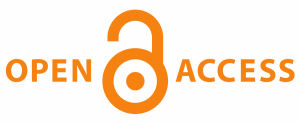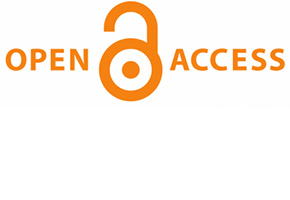“Our mission of disseminating knowledge is only half complete if the information is not made widely and readily available to society.” – Berlin Declaration

Have you ever noticed the little orange Open Access icon while browsing in OneSearch and wondered what it meant?

This small, unassuming icon is actually part of an important movement called Open Access, which is working to change how we create and share information on a global scale. The week of Oct. 25-31 is International Open Access Week, so let’s take a closer look at what Open Access (or OA) actually means, and why it matters!
The Problem
Sooner or later, most people who do research with any regularity, whether students, scholars, or professionals, will hit a paywall — one of those landing pages that asks you to pay money before you can read an article. Most of us are used to seeing paywalls on digital publications such as newspapers and magazines, and while these paywall landing pages can certainly be annoying and even frustrating, it does make a certain sense. After all, these kinds of publications need some sort of funding in order to stay in business and pay their writers a (hopefully) living wage, and paywalls are one funding model that can help them accomplish that.
However, when paywalls are put on academic research, the implications become much more problematic.
A vast amount of knowledge and insight is published every day in the form of academic scholarship. Most research is publicly funded or subsidized in some way — most research funding comes directly from governments, and a large portion of the researchers who produce academic scholarship, either by directly authoring that research or by serving as peer-reviewers, work at publicly-funded institutions (Creative Commons, n.d.; Day et al., 2020). Moreover, researchers publish their work without the expectation of compensation — scholars’ primary motivation in publishing their research is to advance human knowledge.
In theory, these contributions to human knowledge should belong to us, the public, whose taxpayer dollars have largely funded this research, and to whom scholars and researchers have essentially donated their time and effort for the greater good. However, access to most academic research is limited only to researchers affiliated with a well-funded institution, or those who can afford to pay out-of-pocket for individual articles (SPARC, n.d.). Meanwhile, the large academic publishers who limit access to this research make almost unbelievably high profit margins off of this donated time and effort, while adding negligible value themselves (Schmitt, 2018).
You’re beginning to see the problem here, right? Being able to access the latest research in your field is crucial to being able to advance the conversation and contribute new insights and innovations… but right now, the only people who can meaningfully contribute to that conversation are either financially well-off, or are affiliated with universities and other institutions with deep pockets. In practice, this excludes many scholars from historically marginalized populations and backgrounds, as well as wide swaths of academics from the Global South at large.
Not only is this a problem because it perpetuates; it also slows down innovation overall. We need look no further than the COVID-19 pandemic for proof of this: At the beginning of the pandemic, major scientific publishers agreed to remove paywalls on most COVID-19 research. This is wonderful, and it played a major role in scientists being able to develop vaccines at record-breaking speed (Dye et al., 2016; Wellcome, 2020). However, think of all the diseases whose scholarship is still stuck behind paywalls, all the treatments that could have been discovered by now if that research had been freely open and accessible to all.
This is where Open Access comes in.
The Open Access movement is working to transform academic publishing with the goal of making information and knowledge freely accessible to all. This includes open access research and scholarly output, wherein publishers may charge publication fees but make research free and openly available for readers; open educational resources, such as textbooks and other teaching materials; and open data, such as datasets and statistics that are made freely available for download, copy, and analysis.
There are a number of strategies that researchers and institutions can use to attain Open Access. Authors can choose between two tiers of Open Access as they decide how and where to publish their research, referred to as Gold and Green, each model having its strengths and weaknesses. Institutions such as libraries can also renegotiate their contracts with academic publishers through Transformative Agreements that aim to shift the burden of paying for research away from readers.
Where to Learn More About Open Access
Students
You have probably noticed that textbooks can be quite expensive, and they can pose a big financial burden on top of the already-formidable cost of college. The Open Educational Resources (OER) portion of the Open Access Movement is working to lower textbook costs, which can have a direct impact on your life as a college student. If you are worried about paying for college or are interested in learning more about lowering textbook costs, please sign up to attend $avvy Ways to Save Money at C$UN on Wednesday, Oct. 27 from 4:00–5:15pm.
Faculty & Other Researchers
If you produce scholarly research, then you have the power to negotiate with publishers to retain some control over your own research, or to publish in an Open Access journal. We also strongly encourage you to deposit your scholarly output in CSUN’s ScholarWorks Open Access Repository (SOAR). If you are interested in learning more about the current status of Open Access publishing, please also consider attending our Open Access Week event, Open Access Publishing: Costs, Benefits and Myths on Wednesday, Oct. 27 from 11:00am–12:30pm.
If you are a teaching faculty member, then you have the additional opportunity to lower textbook costs for your students by adopting Open Educational Resources or other low-cost course materials. Please visit CSUN Affordable Learning $olutions to learn more about this process.
References
Creative Commons. (n.d.). Open access. Creative Commons. Retrieved October 15, 2021, from https://creativecommons.org/about/program-areas/open-access/
Day, S., Rennie, S., Luo, D., & Tucker, J. D. (2020). Open to the public: Paywalls and the public rationale for open access medical research publishing. Research Involvement and Engagement, 6(1), 8. https://doi.org/10.1186/s40900-020-0182-y
Dye, C., Bartolomeos, K., Moorthy, V., & Kieny, M. P. (2016). Data sharing in public health emergencies: A call to researchers. Bulletin of the World Health Organization, 94(3), 158–158. https://doi.org/10.2471/BLT.16.170860
Max Planck Society. (2003, October 22). The Berlin Declaration on Open Access to Knowledge in the Sciences and Humanities. https://openaccess.mpg.de/Berlin-Declaration
Schmitt, J. (2018, September 5). Paywall: The business of scholarship. https://paywallthemovie.com/paywall
SPARC. (n.d.). Why open matters. Retrieved October 15, 2021, from https://sparcopen.org/why-open-matters/
Wellcome. (2020, January 30). Sharing research data and findings relevant to the novel coronavirus (COVID-19) outbreak. https://wellcome.org/press-release/sharing-research-data-and-findings-relevant-novel-coronavirus-ncov-outbreak



